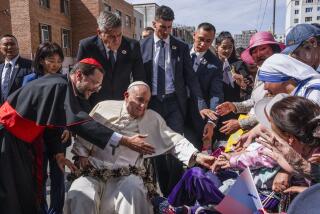China’s Hand Lies Heavy on Tibetan Buddhists
- Share via
WESTERN CHINA — In the shadow of the snowcapped mountains separating China’s western provinces from Tibet, monks at a scattering of Tibetan Buddhist monasteries struggle to keep their religion alive.
Just as part of the daily meditation involves cultivating flowers and trees on the grounds, the monks and lamas are devoted to sowing the seeds of Buddhism in a modern world. On this arid plateau, neither is easy.
“The [Chinese] Constitution says that we are free to practice our religion here,” said one robed lama, 78, sitting in his immaculately tended garden. He asked that neither he nor his monastery be identified. “But holding real ceremonies and training for the young lamas is impossible.”
This week in Washington, their exiled spiritual leader, the Dalai Lama, might make a preliminary overture toward Beijing to find ways Tibet and China can coexist in peace.
“Fifty years of struggle we have engaged in,” the Dalai Lama said Monday at a Washington ceremony honoring human rights activists. “Discrimination, inequality, due to ideology--which is sad--often happens.”
Now, the exiled spiritual leader might concede that Tibet and Taiwan are part of China and should not seek independence, those close to him say. And the Chinese government might respond by permitting broader Tibetan cultural and religious freedom, granting a greater degree of political autonomy and eventually allowing the Dalai Lama to return home.
“I think there is a possibility to develop some kind of mutual trust [with Chinese officials],” the Dalai Lama said last week in a speech at the University of Virginia. His U.S. tour to promote world peace ends Friday.
There is a long history of distrust to overcome. Beijing regards the Dalai Lama as not only a religious leader but a political rival who has driven a wedge between Tibet and Beijing.
The Dalai Lama hasn’t had official contact with Beijing since 1992, though mediators have been working behind the scenes to narrow the gap.
But there is still far to go. Revealing what may have been a desperate protest against Beijing’s attempts to control religious practices here, sources in the Dalai Lama’s government-in-exile in Dharamsala, India, said Friday that the Agya Rinpoche--head of one of the most important monasteries in Tibetan Buddhism, the Kumbum Monastery in Qinghai province northeast of Tibet--apparently defected four months ago.
The rinpoche had been put forward by Beijing as a model of accommodation between Tibetan Buddhists and the Chinese government, and he had recently been selected to educate a 7-year-old boy recognized by China as the Panchen Lama, the highest leader in the faith after the Dalai Lama.
But a schism over who is the real Panchen Lama--the Dalai Lama and Beijing recognize different boys as the current incarnation of the spiritual leader--epitomizes the struggle for control of the religion. Analysts speculate that for the rinpoche, being asked to lend his credibility to the Chinese choice was the last straw.
For decades, since the Dalai Lama fled Tibet in 1959 after a violent uprising against Communist leaders failed, the practice of Tibetan Buddhism in Tibet and China has existed under the scrutiny of Chinese Communist authorities.
During the 1966-76 Cultural Revolution, young Red Guards and Chinese troops bombed virtually every monastery in Tibet; some of those left standing were turned into army camps. All statues of Buddha and the Dalai Lama were smashed and burned, and texts and artifacts were destroyed. Monks fled to India, and those who remained were sent back to their villages, if not to prison.
Since the late ‘70s, monasteries have been rebuilt, although in numbers far fewer than before.
Yet China’s determination to control the spread of Tibetan Buddhist traditions and practices remains as intense as ever, according to monks here and Tibetans exiled abroad. Just last month, Beijing ordered Tibetan Buddhist monks older than 60 to retire--a decision that chokes off teachings from elder monks to the younger generation, the lamas say.
At a Tibetan Buddhist temple in Qinghai province, 49 of the 52 monks older than 60 were forced out, the Qinghai Daily newspaper reported. Young monks were returned to their home villages to attend state-run schools for the completion of their compulsory education--taught in the Chinese language of the occupying Han population, not the monks’ native Tibetan. Twelve teenage monks were banished to labor in the countryside, the newspaper said, and five monks were defrocked.
“Religion does not retire,” said the 78-year-old lama as he fingered a strand of prayer beads. “I will stay here until I die.”
Faced with a perceived challenge to Beijing’s authority, the government has stationed secret police in all monasteries in Tibet and China, monks say, and has banned all references to the Dalai Lama.
At the monasteries in western China, the monks are determined to resist. The elderly monk said that he has prepared his funeral pyre and the clothes he will be dressed in after he dies and that, until then, he has only one mission.
“My only will,” he said, carefully measuring a pinch of snuff onto his thumbnail, “is to rebuild the monasteries. Nothing else matters.”
Times staff writer Zerline A. Hughes in Washington contributed to this report.
More to Read
Sign up for Essential California
The most important California stories and recommendations in your inbox every morning.
You may occasionally receive promotional content from the Los Angeles Times.










